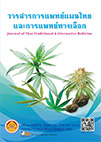The Concept of 8 TCM Therapeutic Methods
Main Article Content
Abstract
An effective treatment requires many different methods, depending on the clinical and physical conditions of the patient. The objective of this article was to collect the concepts of eight traditional Chinese medicine (TCM) therapeutic methods and their clinical applications. These methods were basically developed from the therapeutic methods that were originally recorded in theHuang Ti Nei Jing scripture (Shu Wen part) over 2,400 years ago and had been constantly
evolving until the Qing Dynasty. During that period, Cheng Zhong Ling collected clinical experiences of former TCM doctors, and then got them published as the eight basic therapeutic methods in the book “Medical Revelations” (Yi Xue Xin Wu). The “Eight Methods in Therapy” were based on the holistic approach for diagnosis and treatment in the TCM theory, so-called Pian Joeng Lun Jue. And then the treatment for each individual patient is based on the analysis of symptoms and illness conditions (known as syndrome differentiation and treatment), and the use of appropriate remedy as well as proper herbal drugs according to the real situation to harmonize the body balance. The “Eight Methods in Therapy” are categorized according to their therapeutic actions, namely diaphoretic therapy, purgative therapy, regulating therapy, warming therapy, heat-clearing therapy, nourishing therapy, resolving therapy, and vomiting therapy. Currently, many treatments given by the practitioners are often inclined to choose one side of therapeutic methods for patients, which would be harmful for health in a long run. This review article should be used as guidelines for a comparative treatment study and for choosing appropriate application in clinical practice.
Article Details
References
1. Lin ZH. Zhongyi yongyao de fangfa – zhongyi ba fa jieshao. 1st ed. Guangzhou: Guangdong Science and Technology Press; 2010. (179 p.).
林政宏. 中医用药的方法-中医八法介绍. 第 1 次印刷. 广州 :广东科技出版社;2010. (179 p.).
2. Chen CZ. Zhongyi zhifa yu fangji. 18th ed. Beijing: People’s Health Publishing House; 2013. (814 p.).
陈潮祖.中医治法与方剂.第 18 次印刷.北京:人民卫生出版社; 2013.(814 p.)
3. เย็นจิตร เตชะดำรงสิน (บรรณาธิการ). ตำรับยาจีนที่ใช้บ่อยในประเทศไทย เล่ม 1. พิมพ์ครั้งที่ 1. กรุงเทพฯ: สำนักงานกิจการโรงพิมพ์องค์การทหารผ่านศึกในพระบรมราชูปถัมภ์; 2549. (439 หน้า).
4. Li F. Fangji xue. Vol. I. 1st ed. Beijing: People’s Health Publishing House; 2002. (1,055 p.).
李飞.方剂学. 上册. 第 1 次印刷. 北京:人民卫生出版社; 2002.(1,055 p.).
5. Zuo Yanfu. Internal Medicine of Traditional Chinese Medicine. 1st ed. Shanghai: Shanghai Xinhua printing works; 2002. (1,001 p.).
6. Huang TK. Zhongyao peifang xue. 1st ed. Guangzhou: Chinese Medicine of Guangdong Science and Technology Press; 2000. (786 p.).
黄泰康. 中药配方学. 第 1 次印刷. 广州:中国医药广东科技出版社; 2000.(786 p.).
7. Li F. Fangji xue. Vol.II. 1st ed. Beijing: People’s Health Publishing House; 2002. (996 p.).
李飞.方剂学.下册. 第 1 次印刷. 北京:人民卫生出版社; 2002.(996 p.).
8. Li QY, Yang B. Fangji xue tubiao jie. 1st ed. Beijing: People’s Health Publishing House; 2004. (208 p.).
李庆业,杨斌.方剂学图表解. 第 1 次印刷. 北京:人民卫生出版社; 2004.(208 p.).
9. Zhong GS. Zhongyao xue tubiao jie. 1st ed. Beijing: People’s Health Publishing House; 2004. (360 p.).
钟赣生.中药学图表解. 第 1 次印刷. 北京:人民卫生出版社; 2004.(360 p.).
10. Attilio D' Alberto. The eight strategies (Ba Fa) of TCM from the aspect of formulary. [Internet]. [cited 2015 Aug 5]; Available from: http://medvetacupuncture.org/english/articles/attilio/bafa.html


